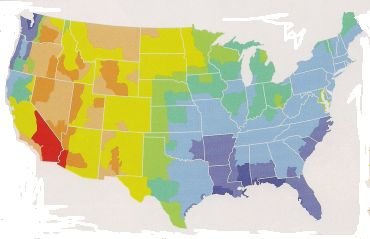Planting Zones
Planting zones are determined by the United States Department of Agriculture. The USDA Hardiness Zone Map is the most common which determines a plants ability to live based on cold temperatures, not hot.
There are other factors included in a plants ability to survive
such as rainfall, frost and a few other factors within a climate.
These USDA maps are also included.
1) Plant Hardiness Zones:
Temperature influences plant growth. Every plant has high and low temperature extremes that they cannot endure.
- When temperatures are too cold for an extended period, the plant's ability to reproduce is curtailed where eventually the plant will die.
- When temperatures are too high, plants dry out where populations die back.
- With either extreme, weeds moves in.
Broken down into 11 zones, individual planting zones represents areas of winter temperature extremes throughout North America. The hardiness plant zone map doesn't take into consideration snow cover, precipitation, humidity, sunlight and seasonal winds.
The USDA map is more effective for the eastern two-thirds of the United States. This is because there are fewer mountains to influence cold air masses. In the mountains of the western regions of US there is much more profound impact within the climate, including more micro-climates. Micro-climates are weather conditions in a small area that can be different than other very close surrounding areas.
The mountains along with the Pacific Ocean also influence hardiness differently than along the east coast of the Atlantic.

|
Zone-------Degree Fahrenheit 3----------- -40 to -30---- 4----------- -30 to -20---- 5----------- -20 to -10---- 6 ----------- -10 to 0 ----- 7--------------0 to 10 ---- 8-- - -------- 10 to 20 ---- 9-------------20 to 30 ---- 10------------30 to 40 ---- --- Not on growing zone map: Alaska/Canada 1 Below -50 2 -50 to -40 Florida/Mexico 11 Above 40 |
------Degree Celsius ------- -39.9 to -34.5 ------- -34.4 to -28.9 ------- -28.8 to -23.4 ------- -23.3 to -17.8 ------- -17.7 to -12.3 ---------12.2 to -6.7 -------- -6.6 to -1.2 -------- -1.1 to 4.4 --------- -45.5 -45.5 to -40 4.4 + |
2) Basic 'Frost Map' helping aid when to plant:
Native plants grow naturally and without problem where climate conditions are most suitable for them. Introduced ornamental plants usually adapt readily if climate and soil are suitable.
Fall frost and spring freezes will also impact plants. If there are any spring freezes, native plants are better programmed to wait for all frosts to pass before they begin growing over introduced plants.
Growing Zones Frost Free Date Frost Date #Days Frost Free
(Spring) (Fall)
____________ _____________ _________ _____________
|
1 June 15th 2 May 15th 3 May 15th 4 May 10th 5 April 30th 6 April 15th 7 April 15th 8 March 10th 9 February 15th 10 January 20th 11 Frost |
July 15th 30 August 15th 90 September 15th 120 September 15th 125 October 15th 165 October 15th 180 October 15th 180 November 15th 245 December 15th 265 December 20th 335 Free |
Suggestions to protect plants from frost include Newspaper, Brown Paper Roll and Weed Control Fabric. Do NOT use plastic to protect plants from freezing - this can burn or even kill them. These can also be used as inorganic mulch.
3) Rainfall Map:
Like temperatures, too much or too little water also affects how plants grow in different climate zones.
- Too little or no water plants become dormant unless adaptable plants are in a light to no rainfall area like a desert.
- Too much water may cause some plants to over-grow crowding out others unless adaptable plants are in a heavy rainfall area like a forest.
- Both too little or too much water can also kill plants if ongoing in planting zones.
- Keep in mind water loss or retention depending on where planted. For example, if there are shade plants beneath canopy trees water stays in soil longer.


0 3.5 7 10.5 14 21 28 35 49 63
All numbers coordinated with colors are in inches for rainfall map above.
FYI:
- Outside of hardiness planting zones, photosynthesis causes plants to grow along with water, light types and soil. In short, local climate controls a plants adaptability to grow in an area - both indoors and out.
- Photosynthesis comes in two forms of light:
Ultraviolet, or blue light
Infrared, or red light
- Length of light exposure to plants plays an important role. If plants grow in area where days are short, they've adapted. Many wildflowers adapt and require long days to grow to full potential. So the length of daylight is important.
Back from Planting Zones to Starting a Garden
Back from Planting Zones to Easy Butterfly Garden.com
 Copyright © 2010-2022 Easy-Butterfly-Garden.com
Copyright © 2010-2022 Easy-Butterfly-Garden.com
Privacy Policy Disclaimer

Join Easy Butterfly Garden on Facebook
Recent Articles
-
Annual Bluegrass
Jan 14, 17 08:14 PM
Annual bluegrass (Poa annua) is considered a weed in the Poa family, which has a few popular turf grasses. If this gets into your butterfly garden listed are a few ways to eradicate it.
-
Candytuft Flowers
Sep 25, 16 10:54 PM
There are the annual, or Iberis, candytuft flowers and also perennials which are called Iberis sempervirens.
-
Keeping Deer Out
Sep 19, 16 01:10 PM
Reviewing the types of products available for keeping deer out of our gardens along with building fences. Many of these products help with other garden pests.
-
Butterfly Meadows
Sep 19, 16 12:52 PM
Compared to other wildlife gardening, butterfly meadows take time and are not for the faint of heart.
-
Natural Gardening
Sep 19, 16 12:32 PM
Natural gardening includes different types of gardens. These garden types create a casual, natural envirionment and help sustain native wildlife which includes butterflies.






New! Comments
Have your say about what you just read! Leave me a comment in the box below.